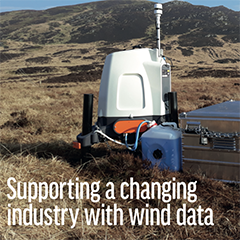Data is the cornerstone of every energy project. Whether it is wind resource data for the purpose of project development, operational data used in the monitoring and optimisation of an existing power plant or power performance data used in the verification and acceptance testing of existing or newly installed individual turbines, the need for low cost, accurate and reliable measurements has never been more important.
Reducing risk and catering for more flexible business models
The wind energy market is continuing to experience a process of change. The removal of subsidies onshore and the challenging pricing framework offshore is driving the need for developers and project owners to achieve commercially competitive stand-alone energy pricing across all new wind projects, whilst optimising the performance and extending the life of existing wind farms. As a result, demand for large volumes of high quality data is increasing as developers try to maximise project finances.
To meet this ever increasing demand for high quality wind data, project developers, owner / operators and asset managers are turning to the now established wind Lidar-based measurement campaigns as a means to replace or supplement traditional mast-based measurements. Lidars have firmly secured their place in the Renewable Energy market as remote sensors capable of providing wind measurements from ground-level up to wind turbine tip heights and beyond, or from turbine nacelle to several rotor diameters ahead of the wind turbine in free wind streams. Lidars are ideally placed to meet the needs of the industry across the entire project lifecycle, from the initial project development phase through to performance optimisation of installed assets.
A newly established yet highly experienced company, ZX Measurement Services, now provide access to the high quality wind data that consultants, project developers and asset owners need through an innovative industry model: Wind Data as a Service.
Here, under the Wind Data as a Service model, customers can gain access to the very latest Lidar technology and expertise, in combination with other sensors and traditional met equipment, without increasing overheads through capital expenditure or recruitment which can be attractive for certain types of organisations as it places tight controls over project costs associated with the acquisition of data. This can both reduce a range of project development risks and corporate overheads, leading to reduced uncertainty and a more financially rewarding project.
As such, Wind Data as a Service is an ideal solution for those organisations struggling with the realities of funding and implementing energy projects in today’s fierce marketplace or those operating a business model where capital expenditure is not the most economical way to fund project development.



























